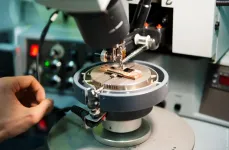(Press-News.org) SAN ANTONIO -- March 18, 2021 -- Working with a team led by French astronomers, Southwest Research Institute scientists helped identify incredibly powerful winds in Jupiter's middle atmosphere for the first time. The team measured molecules exhumed by the 1994 impact of comet Shoemaker-Levy 9 to trace winds in excess of 900 miles per hour near Jupiter's poles.
Jupiter's distinctive red and white bands of swirling clouds allow scientists to track winds in the planet's lower atmosphere, and the SwRI team members have particular expertise in the vivid Jovian aurora, associated with strong winds in the gas giant's upper atmosphere. Until now, wind patterns in the cloudless stratosphere, between the two atmospheric layers, have eluded observation.
"The team of astronomers led by Laboratoire d'Astrophysique de Bordeaux (LAB) in France had to get creative," said SwRI's Dr. Vincent Hue, co-author of an Astronomy & Astrophysics paper describing this research. "They followed fallout from that long-ago comet impact to track molecular evidence, specifically hydrogen cyanide, to measure stratospheric 'jets' -- like Earth's jet streams -- on Jupiter."
The Atacama Large Millimeter/submillimeter Array (ALMA) radio telescope facility allowed scientists to measure stratospheric winds in what they refer to as a unique meteorological beast in our solar system for the first time.
"The most spectacular result is the presence of strong jets, with speeds up to 400 meters per second (900 miles per hour), which are located under the auroras at the poles," said LAB's Thibault Cavalié, lead author of the paper.
"The stratospheric jets could behave like a giant vortex with a diameter up to four times that of Earth," said co-author Bilal Benmahi, also of LAB.
Previous studies predicted that upper-atmosphere winds would decrease in velocity and disappear well before reaching as deep as the stratosphere. The new ALMA data beg to differ, finding surprisingly strong stratospheric winds near Jupiter's pole. SwRI scientists study the Jovian aurora using the SwRI-led Ultraviolet Spectrograph (UVS) aboard NASA's Juno spacecraft, providing their expertise in interpreting these measurements.
Using 42 of ALMA's 66 high-precision antennas, the team measured the Doppler shift of hydrogen cyanide molecules -- tiny changes in the frequency of radiation emitted by the molecules -- caused by the winds in this region of the planet.
"By measuring this shift, we were able to deduce the speed of the winds much like one could deduce the speed of a passing train by the change in the frequency of the train whistle," Hue said.
In addition to the surprising polar winds, the team also used ALMA to confirm the existence of strong stratospheric winds around the planet's equator. The jets spotted in this part of the planet have average speeds of about 370 mph.
"These findings also set the stage for similar yet more extensive measurements to be made by the JUICE mission and its Submillimetre Wave Instrument," said SwRI's Dr. Thomas Greathouse, another co-author, referring to the European Space Agency's JUpiter ICy moons Explorer. JUICE is expected to launch into space next year, carrying the next generation of SwRI's Ultraviolet Spectrograph instrument.
INFORMATION:
ALMA is an international astronomy facility -- managed by a partnership between the European Southern Observatory, the U.S. National Science Foundation and the National Institutes of Natural Sciences of Japan -- in cooperation with the Republic of Chile where the array is located.
For more information, watch the YouTube video at https://youtu.be/JPtsAVAFryo or https://www.aanda.org/10.1051/0004-6361/202140330.
You can also visit visit https://www.swri.org/planetary-science.
Mitochondria are important cellular power plants whose diminished activity has been previously demonstrated to be associated with obesity by a group of researchers at the University of Helsinki. Now, in a new international study coordinated by the University of Helsinki, the researchers have determined that the method of weight loss affects the metabolic pathways of mitochondria in fat tissue, also known as adipose tissue.
The study was recently published in the Journal of Clinical Endocrinology and Metabolism.
The researchers combined two datasets on calorie restriction diets and two datasets on weight loss surgery, or bariatric surgery, from Europe, monitoring dieters' weight loss as well as metabolism. A biopsy was taken from the study subjects' adipose tissue both at ...
Atypical teratoid rhabdoid tumor (ATRT) is a rare brain tumor that predominantly occurs in young children. Scientists at St. Jude Children's Research Hospital used data from two clinical trials to study the molecular groups of ATRT and correlate them with clinical outcomes. A paper detailing the findings was published today in Clinical Cancer Research, a journal of the American Association for Cancer Research.
"If you look at the biology of ATRT, we have learned in the last few years that this is not a single disease but instead there are at least three biologically different groups of the same disease," said first and corresponding author Santhosh Upadhyaya, M.D., St. Jude Department of Oncology. "But what are the outcomes for these different ...
Ticket inspection on public transport can prompt law-abiding people to behave dishonestly once they have gotten off the bus, according to a study published in The Economic Journal. The study was written by three experimental economists: Fabio Galeotti and Marie Claire Villeval of The French National Centre for Scientific Research (CNRS) in the Groupe d'Analyse et de Théorie Economique Lyon St-Etienne (GATE), and Valeria Maggian from Ca' Foscari University of Venice.
In order to study the "side effects" of ticket inspection, researchers designed and carried out a complex large-scale study on public transport and in the streets of Lyon, France. During typical weekdays and avoiding rush hours, ...
- It is as if China is two completely different countries, if we look at how they appear in two such different cases as Africa and the Arctic, says Christer Henrik Pursiainen. He is a professor at the Department of Technology and Security at UiT The Arctic University of Norway.
According to Pursiainen, it is not just the temperature difference that separates Africa from the Arctic. It also provides a good opportunity to take a closer look at how China adapts to two completely different situations and how they use widely differing methods to gain influence.
Together with professors Rasmus ...
Though our galaxy is an immense city of at least 200 billion stars, the details of how they formed remain largely cloaked in mystery.
Scientists know that stars form from the collapse of huge hydrogen clouds that are squeezed under gravity to the point where nuclear fusion ignites. But only about 30 percent of the cloud's initial mass winds up as a newborn star. Where does the rest of the hydrogen go during such a terribly inefficient process?
It has been assumed that a newly forming star blows off a lot of hot gas through lightsaber-shaped outflowing jets and hurricane-like winds launched from the encircling disk by powerful magnetic fields. These fireworks should squelch further growth ...
NEW YORK, NY (March 18, 2021)--Therapies that soothe inflammation could be an effective way to prevent heart disease in people with a common age-related blood condition, according to a new study from researchers at Columbia University Vagelos College of Physicians and Surgeons.
The researchers identified how the blood condition, called clonal hematopoiesis, worsens atherosclerosis, and their findings suggest that an anti-inflammatory drug previously tested in a wider population of people with cardiovascular disease may have potential if used only in those with clonal hematopoiesis.
"The main message from our research is that anti-inflammatory therapies for atherosclerotic heart disease may be particularly effective in patients with clonal hematopoiesis," says Alan Tall, ...
A Russian-German research team has created a quantum sensor that grants access to measurement and manipulation of individual two-level defects in qubits. The study by NUST MISIS, Russian Quantum Center and the Karlsruhe Institute of Technology, published in npj Quantum Information, may pave the way for quantum computing.
In quantum computing the information is encoded in qubits. Qubits (or quantum bits), the quantum mechanical analogue of a classical bit, are coherent two-level systems. A leading qubit modality today superconducting qubits based on the Josephson junction. That is the kind of qubit IBM and Google used in their quantum processors. However, scientists are still searching for the perfect qubit -- the one that can be precisely measured and controlled, ...
Researchers are developing new autonomous technologies that can help people check that isolated elderly family members are okay.
We are living in a world where elderly parents are increasingly distant from their relatives, as many relocate for work opportunities.
There are now more than 4 million people aged 65 and older who are living alone in the UK.
The series of national lockdowns during the coronavirus pandemic has made it even harder for people to check that those elderly loved ones are safe and well.
Families want peace of mind that their elderly relatives are living well, and are maintaining a relatively active lifestyle. Although we can call them to check ...
UNIVERSITY PARK, Pa. -- A team led by researchers in Penn State's College of Agricultural Sciences has developed a diagnostic test that can identify virulent forms of the swine bacterial pathogen Streptococcus equi subspecies zooepidemicus -- often referred to as "Strep zoo" -- which can cause severe illness and death in pigs, other animals and rarely people.
Outbreaks of S. zooepidemicus causing high mortality in swine first were reported in Asia in 1977, and until recently, the pathogen was not thought to be a major concern in North America. However, high-mortality Strep zoo outbreaks occurred in swine herds in Canada, Tennessee, Ohio and Pennsylvania in 2019. Different versions of the pathogen also can cause a range of disease symptoms ...
BOSTON - Patients who regurgitate regularly but without any known cause may have a condition called rumination. Unfortunately, rumination is often confused with other gastrointestinal conditions, which means many patients may not be getting prompt treatment. But a new study by investigators at Massachusetts General Hospital (MGH) in Neurogastroenterology and Motility clearly describes this syndrome, how to distinguish it from other conditions, and how to treat it.
Rumination syndrome is a behavioral problem, in which patients effortlessly and repeatedly regurgitate food into their mouths while eating and sitting upright. It is a learned behavior that is classified as a disorder ...



